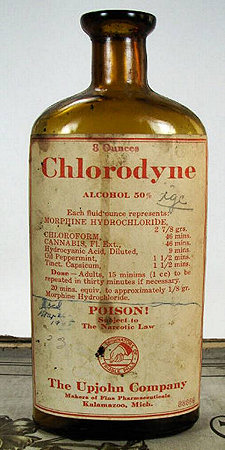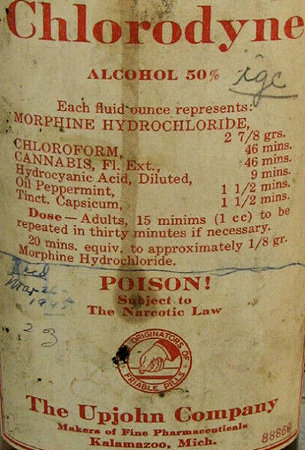|
These nuggets of Upjohn history were distributed via Larry Reeves to everyone on the Pfizer Kalamazoo manufacturing site QTS broadcast emails as "Jeremy's Corner" starting in 2019. Thank you, Larry! |
|
Corner #20 - Upjohn had an art collection of over 1100 items in the early 1990s. The art you see on the walls in 2021 is all from that collection. As you would expect in a corporate collection, none of the items were controversial. Well, there was one, actually. In 1989 it was necessary to buy a large number of art pieces for the then-new Building 298, which is the glass building on the north side of Romence Road. Among the purchases were two cast bronze sculptures created by Mark Chatterly. The one on the left in the photo below was called "Windblown" and the one on the right was "Eternal Muse". They were displayed together near the entrance on the ground floor. I can remember them both still being there in 1998 when I started work in B298. Alas, after ten years of being displayed, one sensitive soul objected to Windblown on the grounds that it was nudity. Upjohn management removed it and stored it out of sight, leaving the Eternal Muse to think on his own. I have a section on the Upjohn website that covers the entire art collection, including the Norman Rockwells. |
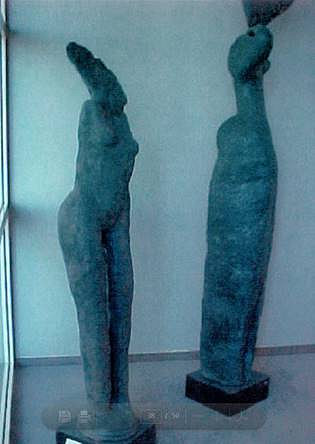
|
Corner #19 - Coal tar is a dark, thick, viscous liquid. Medicinally it was available as a diluted solution for topical application, used to treat psoriasis and dermatitis (dandruff). Even though there has never been any research done to prove its effectiveness, it is still used today quite widely. I would imagine it smells pretty bad. This Upjohn bottle has lot number 83199 on the bottom right of the label and I can date that to 1931. At that time, all Upjohn manufacturing was in Downtown Kalamazoo. Here's a secret that all old pharmaceutical bottle collectors know - don't ever open a bottle. Ever! Twenty-years ago somebody in a Building 41 basement office area found an old Upjohn bottle and opened it. The smell was so bad and so pungent that the area had to be evacuated until the smell dissapated. |
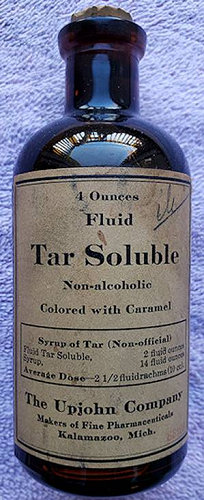
|
Corner #18 - Here's an Upjohn bottle I was recently given. Aconite Leaves come from the plant Aconitum napellus, which is also known as Wolf's Bane or Monkshood. Aconite is considered to be a deadly poison but Upjohn used a very low dose as a sedative. The label claims that it works by slowing the pulse and reducing the force of the heartbeat, a risky treatment as too much could stop the heart. It was used for fevers in children. It's so poisonous there are antidotes to it listed on the label. Since this particular bottle does not have a lot or batch number I would date it to between 1902 to 1910. So why would Upjohn sell a risky product like this? Back in that era there was no research program and no technologies to synthesize active ingredients. Pharmaceutical companies used whatever they could extract from natural sources like plants, roots and even tree bark. In the 1950s there was a section of Building 41 dedicated to this extraction, known as the Percolating Section. Also, patients were desparate for help and willing to take the risk. Thankfully there are much safer and better sedatives available today. |
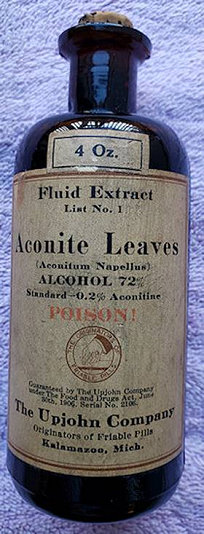
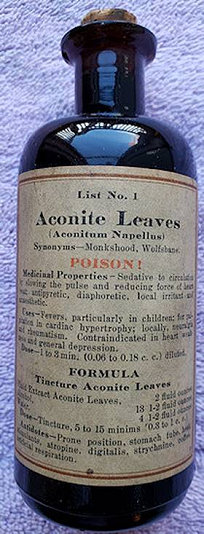
|
Corner #17 - I recently bought a 1987 Upjohn product catalog, scanned it and put it online at this link. It makes interesting reading. Major products at that time were Xanax, Halcion, Cleocin and the Solu/Depo steroid products. All of these are still being sold by Pfizer today. Many of Upjohn's historic OTC products were still being made in Building 41, including Alkets (for indigestion), Cheracol (for coughs), Citrocarbonate (for indigestion) Cortaid (for skin irritation)) Kaopectate (for diarrhoea), Mycitracin (triple antibiotic for skin cuts), Phenolax (a mild laxative first sold in 1910), PAC (pain/fever relief), Pyrroxate (cold relief) and Unicap (multi-vitamin). All of these were all iconic national brands. Gelfoam (which had been a good seller since 1945) and the prostaglandins are in the list, and are still being sold today. Most Upjohn products for the US were made in Building 41 although Xanax and Halcion tablets were made in Puerto Rico to take advantage of large tax breaks. Production equipment was much less automated back then so a small army of people worked in Building 41. API was known as the Chemical Division and the Portage operation was running at capacity making antibiotics and steroids. Upjohn employment in the Kalamazoo/Portage area peaked at 8,000 people around this date but big changes were only two years away. The first layoffs in over a hundred years of company history occurred in 1989. |
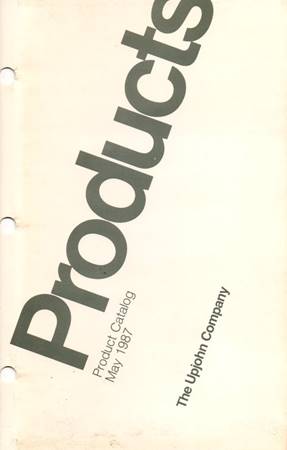
|
Corner #16 - When ibuprofen was approved for over-the-counter (OTC) use in the US during May 1984, it was the first new OTC pain relief medication to enter the marketplace in a generation. Prior to ibuprofen's introduction, nonprescription pain relief was provided by aspirin, marketed since 1899, and acetaminophen, introduced in 1955. Upjohn had a licence from Boots to manufacture and sell Ibuprofen by prescription from 1974. The OTC version, which Upjohn called Nuprin, came along 10 years later. Nuprin tablets were made and packaged in Building 41. It was an immediate hot seller and generated excellent profits for The Upjohn Company until the patent ran out. I ran across the unopened bottle below on eBay and couldn't resist adding it to my collection. The expiration date is 5/87 so it was packaged in either 1984 or 1985. |
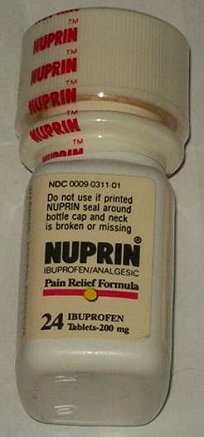
|
Corner #15 - We all know that mercury is toxic. Remember when Building 38 was shut down because of a mercury spill? And we would never ingest it orally, right? Well, from the 17th to the early 20th century a mercury formulation called Blue Mass was sold throughout the country. It was used to treat syphilis, typhoid fever, yellow fever, parasites, constipation and mental health conditions, and it was taken by patients in either pill or syrup form. It contained as much as 33% mercury in either elemental form or mercury chloride. I looked through an 1890 Upjohn catalog and found 43 products containing mercury, the amount of mercury ranging from 1/1000 of a grain to 5 grains (1 grain equals 65mg). Here is an Upjohn Blue Mass bottle from the 1890s. The strength is 3 grains, which is about 65mg of mercury per pill. People who took two of these pills per day had a mercury level in their bodies that was 1000 times higher than today's safe limit. When mercury poisoning symptoms occurred they were usually blamed on a worsening of the original disease. This particular product was made by Upjohn from 1886 to 1925. A 39-year lifespan indicates this was a good seller for the company. Itís well-known that Abraham Lincoln took Blue Mass pills for several years to treat what was then called melancholy (today we would call it depression). However, when taking it he was prone to erratic behavior and violent outbursts. He recognized this and stopped taking the pills, which was a good thing. Nobody wants a president prone to erratic behavior and outbursts. A couple of interesting mercury combination products were mercury plus opium, and mercury plus rhubarb extract. In a 1942 Upjohn sales catalog, there were still 62 mercury-containing products. Thankfully by 1960 there were none. For a look at Upjohn's prducts over the years you can start at this link. |
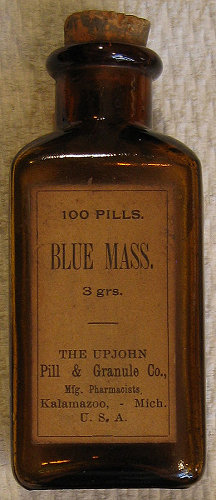
|
Corner #14 - Have you ever wondered what working in a pharmaceutical company was like at the very beginning of the industry? I'm talking about over one-hundred years ago. Blanche Porter started at The Upjohn Company in 1902. I've got a web page on her career, which lasted 52 years, at this link. She worked in Building 41 during her final years as a supervisor in Fluids Packaging. She wrote an article for the internal employee magazine Upjohn News and it makes interesting reading. Apparently people had plenty of fun back then. It was quite common for early employees to work to 50 years of service and more as there was no retiree healthcare and no social security. People just couldn't afford to retire. Blanche is shown below is a typical outfit from the early twentieth century. A lady back then was not supposed to show her ankles! |
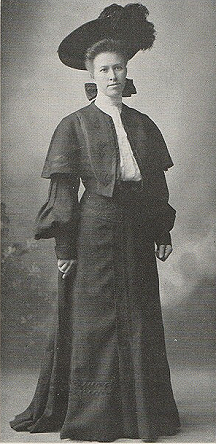
|
Corner #13 - There were a number of celebrities who visited the Upjohn Portage plant. Perhaps the most notable visit was Granny from the popular TV show "The Beverly Hillbillies" (I'm sure this show is still on cable somewhere). The visit occurred in October 1968. The actress who played Granny on the TV series was Irene Ryan. She had been contracted by the company to advertise an Upjohn cough syrup called Cheracol D. I have a web page on her visit at this link. The photo below is of Irene in her Granny costume on one of the custom sofas in Building 88, the corporate headquarters building that used to sit on the south-west corner of the Portage Rd/Romence Rd intersection. Another star to visit was Dale Robertson from the TV series "Tales of Wells Fargo". Here is some info on that visit. |
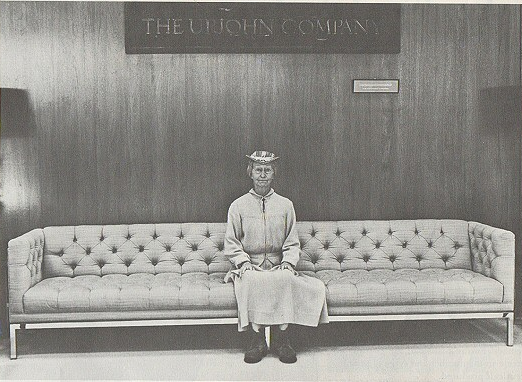
|
Corner #12 - Gelfoam is the oldest product currently made at the Portage site. It dates back to 1946, so Upjohn-Pharmacia-Pfizer have been making it for 74 years. In 2019 the market for Gelfoam was $740 Million but there are other manufacturers. I recently added the Gelfoam bottle and box below to my collection. The look of the label and the box is typical of Upjohn products in the late 1940s and 1950s. Note on the label there is a stock number of 1-609-500. That tells us that this batch of product was for a government contract, probably for use in military hospitals. It was most likely made in Building 41 prior to 1953 |
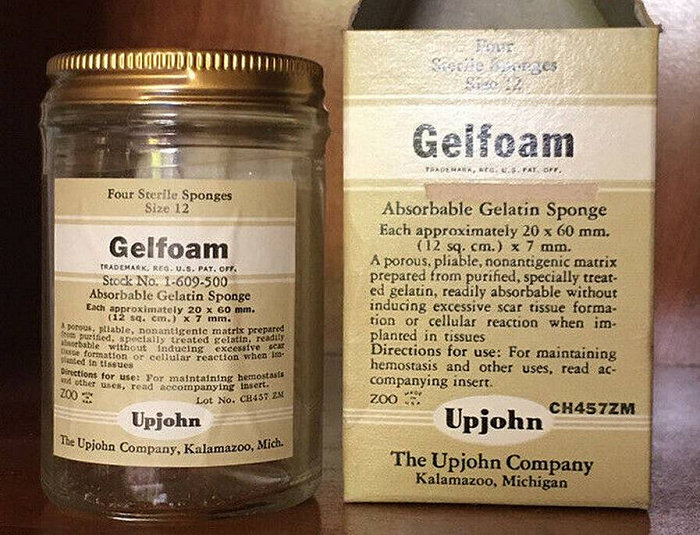
|
Corner #11 - Chlorodyne was probably the most addictive product that The Upjohn Company ever made. It contained morphine and cannabis (marijuana). It claimed to relieve pain, make you sleep and to treat diarrhea. As you can imagine, it could readily fix all those. However, it was so addictive that deaths from overdoses, either accidental or deliberate, became a frequent occurrence. A common feature of the coroner's report in such cases would be the description of the deceased's body being found in a flat or bedsit littered with empty Chlorodyne bottles. Many companies made Chlorodyne. Upjohn manufactured it in its Downtown Kalamazoo manufacturing complex from 1900 to 1937 and from the batch number of 88868 I know that this particular bottle was filled in 1932. Also, note that for many decades Upjohn used an entirely red label as a visual indicator that a product was categorized as a poison. |
